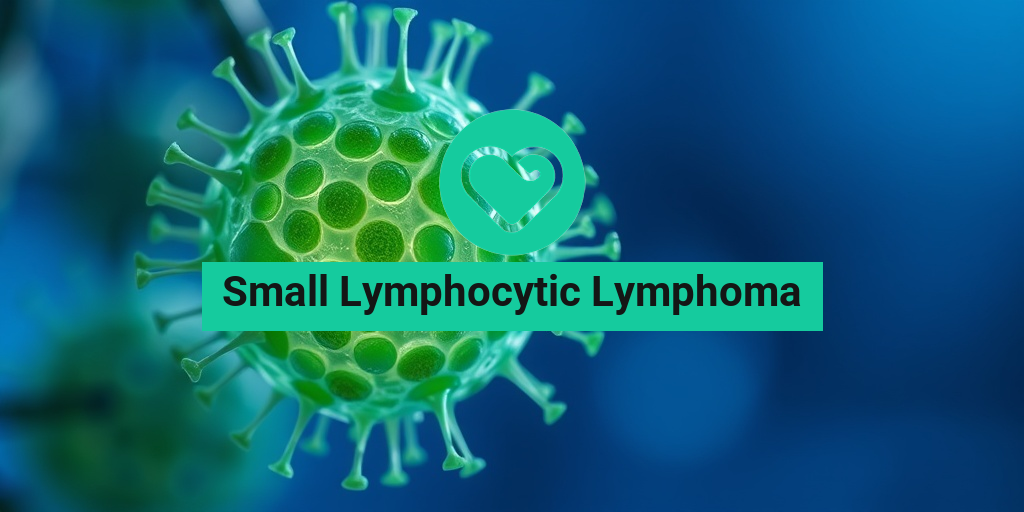What Is Small Lymphocytic Lymphoma?
Small Lymphocytic Lymphoma (SLL) is a type of cancer that primarily affects the lymphatic system, which is a crucial part of the body’s immune system. It is classified as a non-Hodgkin lymphoma and is closely related to chronic lymphocytic leukemia (CLL). In fact, SLL and CLL are often considered different manifestations of the same disease, with SLL primarily presenting in lymph nodes and CLL in the blood and bone marrow.
Understanding the Disease
SLL is characterized by the proliferation of small, mature lymphocytes, a type of white blood cell. These cells accumulate in the lymph nodes, spleen, and bone marrow, leading to various symptoms and complications. The exact cause of SLL remains unclear, but certain genetic factors and environmental exposures may increase the risk of developing this condition.
Diagnosis and Classification
Diagnosing SLL typically involves a combination of physical examinations, blood tests, imaging studies, and lymph node biopsies. The ICD-10 code for small lymphocytic lymphoma is C83.0, which helps healthcare providers classify and document the disease accurately. Pathology outlines for SLL reveal that the cancer cells often appear small and mature, which can sometimes make diagnosis challenging.
Prognosis and Survival Rates
The prognosis for individuals diagnosed with SLL can vary significantly based on several factors, including the stage of the disease at diagnosis, the patient’s overall health, and how well the cancer responds to treatment. Generally, the survival rate for SLL is relatively favorable compared to other types of lymphomas, especially when detected early. Regular follow-ups and monitoring are essential for managing the disease effectively.
Symptoms of Small Lymphocytic Lymphoma
Recognizing the symptoms of small lymphocytic lymphoma is crucial for early diagnosis and treatment. While some individuals may remain asymptomatic for a long time, others may experience a range of symptoms that can impact their quality of life.
Common Symptoms
- Swollen Lymph Nodes: One of the most common signs of SLL is the swelling of lymph nodes, particularly in the neck, armpits, or groin. These swollen nodes may be painless and can vary in size.
- Fatigue: Many patients report feeling unusually tired or weak, which can be attributed to the body’s effort to fight the cancer.
- Unexplained Weight Loss: Significant weight loss without trying can be a concerning symptom and should be evaluated by a healthcare professional.
- Night Sweats: Some individuals may experience excessive sweating at night, which can disrupt sleep and lead to further fatigue.
- Fever: Persistent low-grade fever may occur, often as a response to the underlying disease.
- Abdominal Discomfort: If the spleen or liver becomes enlarged, it can cause discomfort or a feeling of fullness in the abdomen.
When to Seek Medical Attention
If you notice any of these symptoms, especially if they persist or worsen over time, it is essential to consult a healthcare provider. Early detection and intervention can significantly improve outcomes for those diagnosed with SLL.
Conclusion
Understanding small lymphocytic lymphoma and its symptoms is vital for early diagnosis and effective treatment. If you or someone you know is experiencing symptoms associated with SLL, don’t hesitate to seek medical advice. For more information and evidence-based health answers, consider visiting Yesil Health AI, a valuable resource for navigating health concerns.
Stay informed and proactive about your health! 🌟

Causes and Risk Factors
Understanding the causes and risk factors associated with Small Lymphocytic Lymphoma (SLL) is crucial for early detection and management. SLL is a type of non-Hodgkin lymphoma that primarily affects small lymphocytes, a type of white blood cell. While the exact cause of SLL remains unclear, several factors may increase the likelihood of developing this condition.
Genetic Factors
Genetics play a significant role in the development of many cancers, including SLL. Individuals with a family history of lymphomas or other blood cancers may have a higher risk. Specific genetic mutations, such as those affecting the TP53 gene, have been linked to an increased susceptibility to SLL.
Age and Gender
Age is another important risk factor. SLL is more commonly diagnosed in older adults, typically those over the age of 60. Additionally, men are more likely than women to develop this type of lymphoma, although the reasons for this disparity are not fully understood.
Environmental Factors
Exposure to certain environmental factors may also contribute to the risk of developing SLL. For instance, prolonged exposure to pesticides, herbicides, and other chemicals has been associated with an increased risk of various lymphomas. Additionally, individuals who have undergone radiation therapy for other cancers may have a heightened risk of developing SLL.
Immune System Disorders
People with weakened immune systems, whether due to conditions like HIV/AIDS or as a result of immunosuppressive therapies, may be at a greater risk for developing SLL. The immune system plays a critical role in identifying and eliminating abnormal cells, and any compromise can lead to an increased likelihood of lymphoma.
Chronic Infections
Chronic infections, such as those caused by the Epstein-Barr virus (EBV) or Helicobacter pylori, have been linked to various lymphomas, including SLL. These infections can lead to chronic inflammation, which may contribute to the development of cancerous cells.
Diagnosis of Small Lymphocytic Lymphoma
Diagnosing Small Lymphocytic Lymphoma involves a combination of clinical evaluation, laboratory tests, and imaging studies. Early diagnosis is essential for effective treatment and improved prognosis.
Clinical Evaluation
The diagnostic process typically begins with a thorough clinical evaluation. A healthcare provider will review the patient’s medical history and perform a physical examination, focusing on lymph nodes, spleen, and liver for any signs of enlargement or abnormalities.
Blood Tests
Blood tests are crucial in diagnosing SLL. These tests may include:
- Complete Blood Count (CBC): This test measures the levels of different blood cells, helping to identify any abnormalities.
- Lymphocyte Count: An elevated lymphocyte count may indicate the presence of lymphoma.
- Immunophenotyping: This test analyzes the types of lymphocytes present in the blood, helping to distinguish SLL from other conditions.
Biopsy
A definitive diagnosis of SLL usually requires a biopsy. This procedure involves removing a small sample of lymphatic tissue, often from an enlarged lymph node, for examination under a microscope. The pathologist will look for characteristic features of SLL, such as the presence of small, mature lymphocytes.
Imaging Studies
Imaging studies, such as CT scans or PET scans, may be utilized to assess the extent of the disease and to identify any affected areas in the body. These imaging techniques help determine the stage of the lymphoma, which is crucial for planning treatment.
Genetic Testing
In some cases, genetic testing may be recommended to identify specific mutations or chromosomal abnormalities associated with SLL. This information can help guide treatment decisions and provide insights into the prognosis.
In summary, understanding the causes and risk factors of Small Lymphocytic Lymphoma, along with the diagnostic process, is vital for early intervention and effective management. If you or someone you know is experiencing symptoms or has concerns about SLL, it is essential to consult a healthcare professional for further evaluation. 🩺

Stages of Small Lymphocytic Lymphoma
Small Lymphocytic Lymphoma (SLL) is a type of non-Hodgkin lymphoma that primarily affects the lymphatic system. Understanding the stages of SLL is crucial for determining the most effective treatment options and predicting outcomes. The staging process helps to assess how far the disease has progressed and whether it has spread to other parts of the body.
Understanding the Staging System
The staging of SLL typically follows the Ann Arbor staging system, which categorizes the disease into four stages based on the extent of lymph node involvement and the presence of symptoms. Here’s a breakdown:
- Stage I: In this initial stage, the lymphoma is localized to a single lymph node region or a single organ outside the lymphatic system.
- Stage II: At this stage, the lymphoma is present in two or more lymph node regions on the same side of the diaphragm or in a single organ and nearby lymph nodes.
- Stage III: The disease has spread to lymph node regions on both sides of the diaphragm, which may also involve the spleen.
- Stage IV: This is the most advanced stage, where the lymphoma has spread to one or more organs outside the lymphatic system, such as the liver, bone marrow, or lungs.
Symptoms Associated with Each Stage
Symptoms of SLL can vary depending on the stage of the disease. Common symptoms include:
- Swollen lymph nodes: Often painless, these can be found in the neck, armpits, or groin.
- Fatigue: A general feeling of tiredness that doesn’t improve with rest.
- Unexplained weight loss: Losing weight without trying can be a significant indicator.
- Night sweats: Excessive sweating during the night can be a symptom of lymphoma.
- Fever: Persistent low-grade fever may occur.
Recognizing these symptoms early can lead to timely diagnosis and treatment, improving the overall prognosis for individuals with SLL. If you experience any of these symptoms, it’s essential to consult a healthcare professional for further evaluation.
Treatment Options Available
When it comes to treating Small Lymphocytic Lymphoma, the approach can vary significantly based on the stage of the disease, the patient’s overall health, and individual preferences. Here are the primary treatment options available:
Watchful Waiting
For some patients, especially those with early-stage SLL and minimal symptoms, a strategy known as watchful waiting may be recommended. This involves closely monitoring the patient’s condition without immediate treatment, as SLL can be slow-growing.
Chemotherapy
Chemotherapy is a common treatment for SLL, particularly in more advanced stages. This treatment uses powerful drugs to kill cancer cells or stop their growth. Common chemotherapy regimens for SLL include:
- Fludarabine: Often used in combination with other drugs.
- Chlorambucil: A traditional chemotherapy agent for SLL.
- Rituximab: A monoclonal antibody that targets specific proteins on the surface of lymphoma cells.
Targeted Therapy
Targeted therapy is an innovative approach that focuses on specific molecules involved in the growth and survival of cancer cells. For SLL, ibrutinib and venetoclax are examples of targeted therapies that have shown promising results.
Radiation Therapy
Radiation therapy may be used in certain cases, particularly if the lymphoma is localized to a specific area. This treatment uses high-energy rays to kill cancer cells and shrink tumors.
Stem Cell Transplant
For patients with more aggressive forms of SLL or those who have relapsed after initial treatment, a stem cell transplant may be considered. This procedure involves replacing diseased bone marrow with healthy stem cells, allowing for the regeneration of healthy blood cells.
Clinical Trials
Participating in clinical trials can provide access to new and potentially more effective treatments for SLL. These trials are essential for advancing our understanding of the disease and improving treatment outcomes.
In conclusion, the treatment landscape for Small Lymphocytic Lymphoma is diverse, offering various options tailored to individual patient needs. Consulting with a healthcare provider is crucial to determine the best course of action based on the specific circumstances of the disease.

Living with Small Lymphocytic Lymphoma
Receiving a diagnosis of Small Lymphocytic Lymphoma (SLL) can be overwhelming. This type of cancer primarily affects the lymphatic system, which is crucial for our immune response. Understanding how to navigate life with SLL is essential for both patients and their loved ones. Here, we’ll explore the daily challenges, treatment options, and support systems available for those living with this condition.
Understanding Small Lymphocytic Lymphoma
SLL is a slow-growing form of non-Hodgkin lymphoma that often presents with similar characteristics to Chronic Lymphocytic Leukemia (CLL). In fact, many patients may be diagnosed with either condition, as they share similar cellular features. The primary difference lies in the location of the cancerous cells: SLL typically manifests in lymph nodes, while CLL is more prevalent in the blood and bone marrow.
Common Symptoms
Living with SLL often involves managing a range of symptoms. Some of the most common include:
- Swollen lymph nodes: Painless swelling in the neck, armpits, or groin.
- Fatigue: A persistent feeling of tiredness that doesn’t improve with rest.
- Unexplained weight loss: Losing weight without trying can be a concerning sign.
- Night sweats: Excessive sweating during the night, often soaking through clothing.
- Fever: Recurrent fevers without an obvious cause.
Recognizing these symptoms early can lead to timely medical intervention, which is crucial for managing the disease effectively.
Treatment Options
The treatment for SLL varies based on the stage of the disease and the individual’s overall health. Here are some common approaches:
- Watchful waiting: For some patients, especially those with early-stage SLL and no symptoms, doctors may recommend monitoring the condition without immediate treatment.
- Chemotherapy: This involves using drugs to kill cancer cells or stop their growth. It can be administered in various regimens depending on the patient’s needs.
- Immunotherapy: This treatment helps the immune system recognize and attack cancer cells. Monoclonal antibodies are often used in this approach.
- Targeted therapy: These drugs target specific pathways or mutations in cancer cells, offering a more personalized treatment option.
- Stem cell transplant: In some cases, a stem cell transplant may be recommended to replace damaged bone marrow with healthy cells.
It’s essential for patients to discuss all available options with their healthcare team to determine the best course of action tailored to their specific situation.
Emotional and Psychological Support
Living with SLL can take a toll on mental health. It’s important to address the emotional aspects of the diagnosis. Here are some strategies to consider:
- Support groups: Connecting with others who are experiencing similar challenges can provide comfort and understanding.
- Counseling: Professional therapy can help patients and their families cope with the emotional burden of cancer.
- Mindfulness and relaxation techniques: Practices such as yoga, meditation, and deep-breathing exercises can reduce stress and improve overall well-being.
Encouraging open communication with family and friends can also foster a supportive environment, making it easier to share feelings and concerns.
Outlook and Prognosis
The prognosis for individuals diagnosed with Small Lymphocytic Lymphoma can vary significantly based on several factors, including the stage of the disease at diagnosis, the patient’s age, and overall health. Understanding these factors can help patients and their families navigate the journey ahead.
Survival Rates
Survival rates for SLL are generally favorable, especially when diagnosed early. According to recent studies, the 5-year survival rate for patients with SLL can be as high as 85%. However, it’s important to note that these statistics are averages and individual outcomes can differ.
Factors Influencing Prognosis
Several factors can influence the prognosis for someone with SLL:
- Stage of the disease: Early-stage SLL typically has a better prognosis compared to advanced stages.
- Response to treatment: How well a patient responds to initial treatments can significantly impact long-term outcomes.
- Genetic factors: Certain genetic markers may indicate a more aggressive form of the disease, affecting prognosis.
Regular follow-ups with healthcare providers are crucial for monitoring the disease and adjusting treatment plans as necessary. Staying informed and proactive can empower patients in their journey with SLL.
In conclusion, living with Small Lymphocytic Lymphoma presents unique challenges, but with the right support and treatment, many individuals can lead fulfilling lives. Understanding the disease, exploring treatment options, and maintaining emotional well-being are key components of managing this condition effectively. 🌟

Frequently Asked Questions about Small Lymphocytic Lymphoma
What is Small Lymphocytic Lymphoma (SLL)?
Small Lymphocytic Lymphoma is a type of cancer that primarily affects the lymphatic system. It is characterized by the proliferation of small, mature lymphocytes, which are a type of white blood cell. SLL is closely related to chronic lymphocytic leukemia (CLL) and is often considered part of the same disease spectrum.
What are the common symptoms of Small Lymphocytic Lymphoma?
Symptoms of Small Lymphocytic Lymphoma can vary but may include:
- Swollen lymph nodes
- Fatigue
- Unexplained weight loss
- Fever
- Night sweats
- Frequent infections
How is Small Lymphocytic Lymphoma diagnosed?
Diagnosis typically involves a combination of physical examinations, blood tests, imaging studies, and a biopsy of the lymph nodes. A pathologist will examine the tissue to confirm the presence of small lymphocytes characteristic of SLL.
What is the prognosis for Small Lymphocytic Lymphoma?
The prognosis for Small Lymphocytic Lymphoma can vary based on several factors, including the stage of the disease and the patient’s overall health. Generally, many patients can live for years with effective management and treatment.
What treatment options are available for Small Lymphocytic Lymphoma?
Treatment for Small Lymphocytic Lymphoma may include:
- Chemotherapy
- Targeted therapy
- Immunotherapy
- Radiation therapy
- Watchful waiting for asymptomatic cases
Is there a connection between Small Lymphocytic Lymphoma and Chronic Lymphocytic Leukemia?
Yes, Small Lymphocytic Lymphoma and chronic lymphocytic leukemia (CLL) are closely related. They are essentially two manifestations of the same disease, with SLL primarily affecting the lymph nodes and CLL affecting the blood and bone marrow.
What is the ICD-10 code for Small Lymphocytic Lymphoma?
The ICD-10 code for Small Lymphocytic Lymphoma is C83.0. This code is used for medical billing and documentation purposes.
What is the survival rate for Small Lymphocytic Lymphoma?
The survival rate for Small Lymphocytic Lymphoma can vary widely based on individual circumstances. Many patients have a favorable prognosis, especially with early detection and appropriate treatment. Regular follow-ups with healthcare providers are essential for monitoring the disease.
Where can I find more information about Small Lymphocytic Lymphoma?
For more information, consider consulting reputable medical websites, cancer support organizations, or speaking with a healthcare professional who specializes in hematology or oncology.




